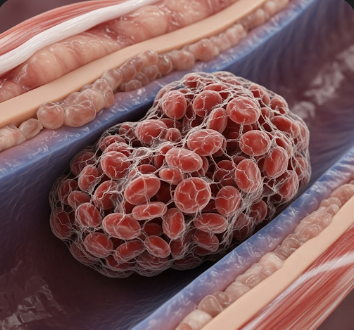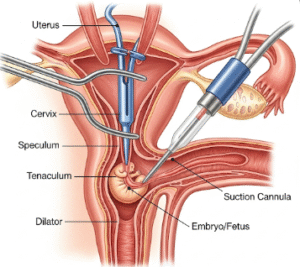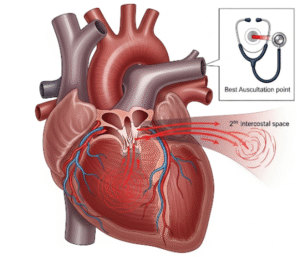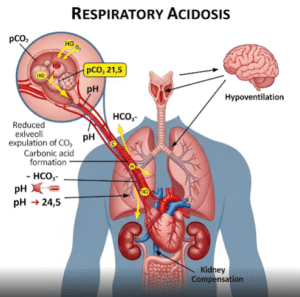Overview
A blood clot, medically known as thrombosis, is a clump of blood that has changed from a liquid to a gel-like or solid state. Blood clots are part of the body’s normal healing process, stopping bleeding after an injury. However, abnormal clot formation inside blood vessels can be dangerous, potentially leading to life-threatening conditions such as deep vein thrombosis (DVT), pulmonary embolism (PE), or stroke.
In Korea, hospitals and clinics offer advanced diagnostic imaging, anticoagulation therapy, minimally invasive interventions, and preventive care to manage blood clots effectively. Early detection and treatment are critical to prevent serious complications and improve survival rates.
What is a Blood Clot?
A blood clot is a semi-solid mass formed from platelets, fibrin, and red blood cells that forms to stop bleeding. While protective at the site of an injury, abnormal clots may develop within veins or arteries without injury. Blood clots are classified as:
- Venous clots: Form in veins, commonly in the legs (DVT), which can travel to the lungs (pulmonary embolism)
- Arterial clots: Form in arteries, potentially causing heart attacks or strokes
- Microclots: Tiny clots in smaller vessels, sometimes linked to inflammatory or clotting disorders
Risk factors, underlying diseases, and lifestyle habits significantly affect the likelihood of abnormal clot formation.
Symptoms
The symptoms of a blood clot depend on its location and size:
Deep Vein Thrombosis (DVT):
- Swelling in one leg
- Pain or tenderness, often in the calf
- Warmth and redness over the affected area
- Leg heaviness or cramping
Pulmonary Embolism (PE):
- Sudden shortness of breath
- Chest pain that may worsen with deep breathing
- Rapid heart rate or palpitations
- Coughing up blood
Arterial clots (stroke or heart attack):
- Sudden weakness or numbness in the face, arm, or leg
- Difficulty speaking or understanding speech
- Vision problems in one or both eyes
- Severe chest pain or pressure
- Lightheadedness or fainting
Symptoms may appear suddenly or develop gradually, depending on the clot size and location. Immediate medical attention is crucial.
Causes
Blood clots form when blood flow is slowed, abnormal, or blood composition changes, often due to one or more of the following:
- Injury to blood vessels: Trauma, surgery, or inflammation
- Immobility: Long flights, hospitalization, or bed rest leading to venous stasis
- Medical conditions: Cancer, heart disease, stroke, or autoimmune disorders
- Genetic clotting disorders: Factor V Leiden, prothrombin mutation, or protein C/S deficiency
- Pregnancy and postpartum period: Increased risk due to hormonal changes
- Hormonal therapy or oral contraceptives: Estrogen increases clotting tendency
- Lifestyle factors: Smoking, obesity, sedentary behavior
- Dehydration: Thickens blood and promotes clot formation
Risk Factors
- Age over 60, increasing risk of both venous and arterial clots
- Obesity or overweight status
- History of previous blood clots or clotting disorders
- Prolonged immobility due to travel, hospitalization, or paralysis
- Surgery, especially orthopedic or major abdominal procedures
- Pregnancy or hormone replacement therapy
- Smoking and cardiovascular risk factors such as hypertension or diabetes
Complications
Blood clots can lead to serious and potentially fatal complications:
- Pulmonary embolism: When a clot travels to the lungs, causing respiratory failure
- Stroke: Arterial clot blocks blood flow to the brain
- Heart attack: Arterial clot in coronary arteries reduces blood supply to heart muscle
- Post-thrombotic syndrome: Chronic leg pain, swelling, or ulcers after DVT
- Organ damage: Clots in kidneys, liver, or intestines impair organ function
- Death: Untreated massive clots, especially PE, can be fatal
Prevention
Preventive strategies focus on reducing risk factors, maintaining circulation, and early detection:
- Regular physical activity: Promotes blood flow and reduces stasis
- Avoid prolonged immobility: Walk or stretch during long travel or bed rest
- Maintain healthy weight: Obesity increases clotting risk
- Hydration: Adequate fluid intake reduces blood viscosity
- Avoid smoking: Smoking increases risk of arterial and venous clots
- Medication adherence: For high-risk individuals, anticoagulants may be prescribed
- Compression stockings: Prevent DVT in hospitalized or high-risk patients
- Monitoring hormone therapy: Evaluate risk before using oral contraceptives or HRT
Treatment Options in Korea
Diagnosis
Korean medical centers use advanced diagnostic methods to detect blood clots:
- Ultrasound (Doppler) imaging: Detects DVT in veins
- CT pulmonary angiography: Identifies pulmonary embolism
- MRI or venography: Evaluates deep or complex clots
- Blood tests: D-dimer, clotting factor analysis, and genetic testing
- Electrocardiogram and echocardiography: Assess heart-related clot complications
Medical Management
- Anticoagulants (blood thinners): Heparin, warfarin, or direct oral anticoagulants (DOACs) prevent clot growth
- Thrombolytics: Medications to dissolve large, life-threatening clots
- Pain relief and supportive care: Managing discomfort and reducing swelling
- Lifestyle modification guidance: Diet, exercise, and smoking cessation
Surgical and Procedural Management
- Catheter-directed thrombolysis: Minimally invasive clot removal
- Inferior vena cava (IVC) filter: Prevents clots from reaching lungs in high-risk patients
- Surgical thrombectomy: Rarely, open surgery may be required for large or obstructive clots
Supportive Care
- Monitoring for recurrence and medication side effects
- Rehabilitation for post-stroke or post-embolism patients
- Education on recognizing early signs of DVT, PE, or stroke
- Regular follow-up with hematologists or cardiologists for high-risk individuals
Prognosis
The prognosis of blood clots in Korea depends on early detection, treatment, and underlying cause:
- Prompt anticoagulation therapy significantly reduces morbidity and mortality
- Recurrent clots are preventable with lifestyle modifications and medication adherence
- Severe complications such as PE or stroke can be managed successfully if diagnosed early
- With comprehensive care, most patients recover function and maintain quality of life













